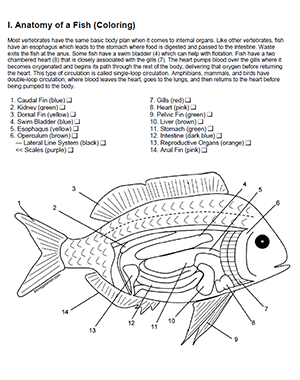
Learn the anatomy of the fish with this coloring worksheet.
- Skeleton: Bony fish have an endoskeleton composed mostly of bone. Their skeleton provides support, protection, and serves as an anchor for their muscles.
- Fins: They have various fins, including dorsal fins (on the back), pelvic fins (lower front), pectoral fins (upper sides), anal fins (near the tail). These fins aid in stability, maneuvering, and propulsion.
- Scales: Bony fish are covered with scales, which are usually made of bone or enamel-like material. Scales protect the fish from injuries and help reduce friction while swimming.
- Gills: They breathe through gills, which are respiratory organs located on the sides of the head. Gills extract oxygen from the water as it flows over the gill filaments.
- Swim Bladder: Many bony fish have a swim bladder, an internal gas-filled organ that helps them control their buoyancy.
- Digestive System: Bony fish have a digestive system that includes a mouth, esophagus, stomach, intestines, and anus.
- Reproductive System: They reproduce sexually and have various reproductive strategies, with some laying eggs externally while others give birth to live young.
- Nervous System: Bony fish have a brain and nervous system that allows them to perceive their environment, process information, and react to stimuli.
- Sense Organs: They possess well-developed sensory organs including eyes adapted to aquatic vision, a lateral line system that detects changes in water movement, and sensory organs on their skin to detect touch and vibrations.
- Musculature: Their muscles are key for locomotion. They have a series of muscles arranged in segments along their body called myotomes, allowing for the flexing and movement needed for swimming.
Student Activity
This coloring worksheet. provides a basic overview of the anatomy of a bony fish. Students color the fish according to the directions with each organ and fins being labeled by number.
Students will not need a reference to complete the activity, as it is a color by number. Each structure has a brief description of the function, which can be used to answer questions.
In addition to fish internal anatomy, this worksheet has an image of a fish scale with instructions on how to use the rings of a scale to estimate the age of the fish. Students color winter growth blue and summer growth green.
Finally, students color the fins of a fish as seen in an external view, which includes the dorsal, caudal, pectoral, pelvic, and anal fins.
Grade Level: 7-9
Time Required: 30-45 min
HS-LS1-2 Develop and use a model to illustrate the hierarchical organization of interacting systems that provide specific functions within multicellular organisms

